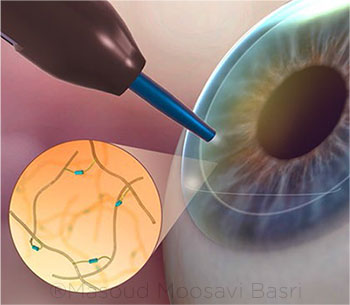Download PDF
A team of researchers has described a simple treatment for the repair of corneal wounds that involves nothing more than a tube of adhesive and visible light.1 In animal models, GelCore (for “gel for corneal regeneration”), a transparent bioadhesive gel that is still in development, sealed the eyeball and filled structural defects in the cornea for long periods of time without sutures, grafts, or bandage contact lenses.
“GelCore provides an alternative to current standard treatment options,” said Nasim Annabi, PhD, at the University of California, Los Angeles. “It is designed to be applied easily, without the need for an operating theater, surgical skills, or even surgery rooms.” She singled out its potential on battlefields, where ocular injuries account for over 10% of injuries sustained by soldiers in combat.
Gelatin plus light. GelCore is a naturally derived biopolymer with characteristics similar to the native cornea. It is made from chemically modified porcine gelatin mixed with light-activated compounds. After application to the wound and brief exposure to a visible light cross-linking system, GelCore solidifies and firmly adheres to the corneal tissue, sealing the defect without sutures. To overcome biosafety concerns, the light intensity used in the cross-linking system is well below the maximum exposure limit, the researchers said.
 |
NO SUTURES. The biopolymer solution is injected into the corneal defect and exposed to visible light, forming the hydrogel.
|
Early results. Tests in rabbit eyes indicated that GelCore effectively sealed corneal defects and also promoted re-epithelization. In tests of wound closure strength, shear resistance, and burst pressure, GelCore performed significantly better than existing adhesives, which lack both high adhesion to wet corneal tissue and long-term retention.
“The glues in current use are associated with low biocompatibility, low adhesion, and poor transparency, and they are undesirably rough and difficult to handle,” said Dr. Annabi. “Our biomaterial has shown prolonged retention even when filling in large corneal tissue defects. And it could regenerate the damaged corneal tissue.”
Potential uses. GelCore is designed mainly for corneal deep scars, but the researchers are working on different formulations for uses ranging from large lacerations and corneal scars to infection and inflammation.
Dr. Annabi noted that its physical and chemical properties can be fine-tuned for use not only in the cornea but also elsewhere in the body, including the lungs, skin, and heart. Moreover, she said, the gel can be used as a platform for delivering antimicrobial agents or drugs to a targeted site to foster wound healing and prevent infection.
Years to market. Since testing in human patients has not yet begun, it could take five to six years to reach the market, Dr. Annabi said.
—Miriam Karmel
___________________________
1 Sani ES et al. Sci. Adv. Published online March 20, 2019.
___________________________
Relevant financial disclosures—Dr. Annabi: NIH: S; UCLA: S; U.S. Department of Defense: S.
For full disclosures and the disclosure key, see below.
Full Financial Disclosures
Dr. Annabi NIH: S; UCLA: S; U.S. Department of Defense: S.
Dr. Baker Alcon: S; Genentech: S; Novartis: S; Regeneron: S.
Dr. Solomon Alcon: C,S; AqueSys: C; ClarVista Medical: C; Glaukos: C; Icon Bioscience: C; Integrity Digital Solutions: C; Mati Therapeutics: C; Octane Visionary VC Fund: C; OcuHub: C; Omeros: C; PogoTec: C; PRN: C; Versant Ventures: C.
Dr. Stewart Carl Zeiss Meditec: C; Genentech: C; Merck: C.
Disclosure Category
|
Code
|
Description
|
| Consultant/Advisor |
C |
Consultant fee, paid advisory boards, or fees for attending a meeting. |
| Employee |
E |
Employed by a commercial company. |
| Speakers bureau |
L |
Lecture fees or honoraria, travel fees or reimbursements when speaking at the invitation of a commercial company. |
| Equity owner |
O |
Equity ownership/stock options in publicly or privately traded firms, excluding mutual funds. |
| Patents/Royalty |
P |
Patents and/or royalties for intellectual property. |
| Grant support |
S |
Grant support or other financial support to the investigator from all sources, including research support from government agencies (e.g., NIH), foundations, device manufacturers, and/or pharmaceutical companies. |
|
More from this month’s News in Review